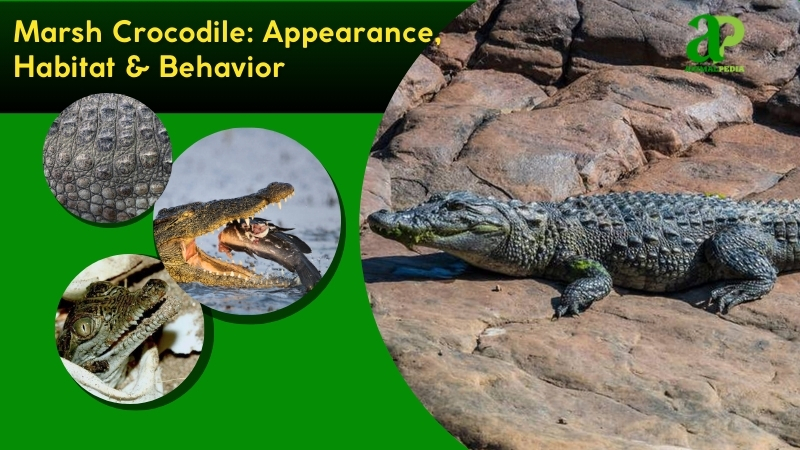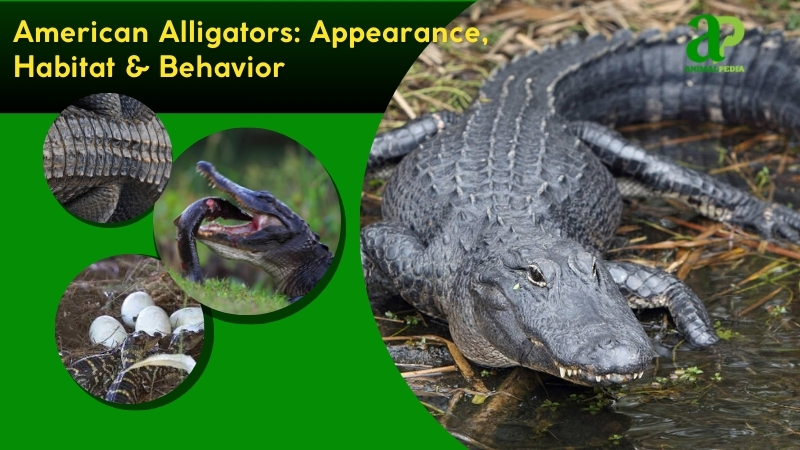Saltwater crocodiles (Crocodylus porosus), the largest living reptiles, dominate with a single species in their genus. These massive creatures boast rugged, armored skin with overlapping scales—dark grayish-green in adults, paling to yellowish on the underbellies. Males often reach 20-23 feet (6-7 meters) in length, weighing up to 2,200 pounds (1,000 kilograms), dwarfing females at 10-13 feet (3-4 meters). Their broad snouts, powerful jaws, and piercing eyes atop their heads scream apex predators. Found across northern Australia, Southeast Asia, and Pacific islands such as Papua New Guinea and the Solomon Islands, they are known for their size and strength.
These crocodiles rule coastal brackish waters, estuaries, and rivers, spanning from India’s eastern coast to northern Australia’s wetlands. Known as “salties,” they adapt seamlessly to saltwater and often swim hundreds of kilometers across open seas. Key habitats include mangrove swamps and deltas-perfect ambush zones. Their geographic range highlights their resilience, as they thrive in tropical and subtropical climates where prey abounds.
Apex predators, saltwater crocodiles excel as ambush hunters. They lurk beneath water, exploding with lethal force to snag prey-fish, birds, mammals, and even sharks. Their diet flexes with opportunity, favoring large ungulates like water buffalo. Territorial and solitary, they defend domains fiercely. Human attacks, though rare, spike near nesting sites or during food scarcity, cementing their fearsome reputation.
Mating peaks in the wet season (November to March). Females lay 40-60 eggs in mound nests, enduring a 90-day incubation. Hatchlings emerge, chirping, under maternal guard-yet predation slashes survival rates. Juveniles grow fast, maturing at 12-15 years, with lifespans stretching to 70 years in the wild.
This article dissects the saltwater crocodile’s anatomy, habitat, and behavior-unveiling a predator supreme in size, power, and ecological impact.
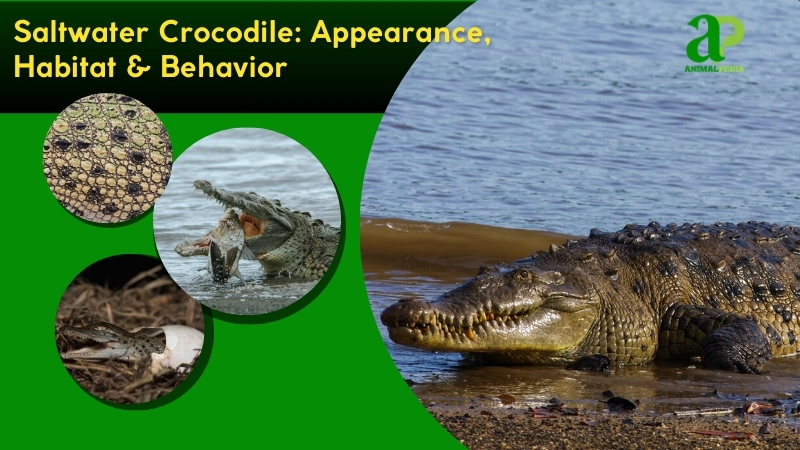
What does the Saltwater crocodile look like?
Saltwater crocodiles have massive, streamlined bodies covered in dark grayish-green scales that fade to yellowish-white on their undersides. This coloration helps them camouflage in murky waters. Their skin consists of tough osteoderms—bony plates embedded within scales—creating natural armor.
Their most distinctive feature is a broad, triangular head with elevated eyes that allow them to see while mostly submerged. The mouth contains 66 sharp, conical teeth designed for gripping prey. Their powerful jaws deliver one of the strongest bite forces in the animal kingdom.
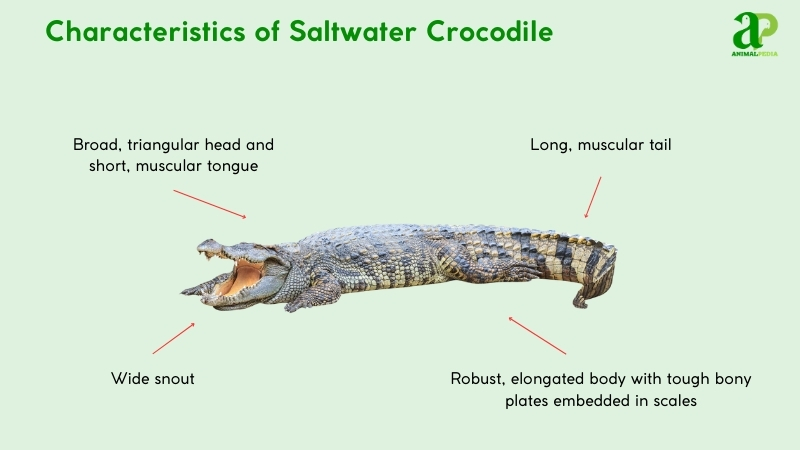
Distinguishing characteristics include a wider snout than the Nile crocodile and a bulkier build than the American alligator. Their thick, muscular neck connects to a barrel-shaped torso supported by strong limbs with sharp, curved claws.
The muscular tail makes up about half their body length and propels them through water at speeds up to 15 miles (24 kilometers) per hour. Male saltwater crocodiles can reach weights of 2,200 pounds (1,000 kilograms), making them the largest reptile on Earth and the biggest of all crocodilian species.
How big do Saltwater crocodiles get?
Saltwater crocodiles average 20 feet (6 meters) in length and 2,200 pounds (1,000 kilograms) for males, while females reach 10-13 feet (3-4 meters) and 330-440 pounds (150-200 kilograms). These giants dominate as the largest crocodilian family. A heavyweight contender weighing 2,640 pounds (1,200 kilograms) surfaced in the Philippines, per Grigg and Kirshner (2015). Adult males typically hit 18-23 feet (5.5-7 meters) snout-to-tail, dwarfing females.
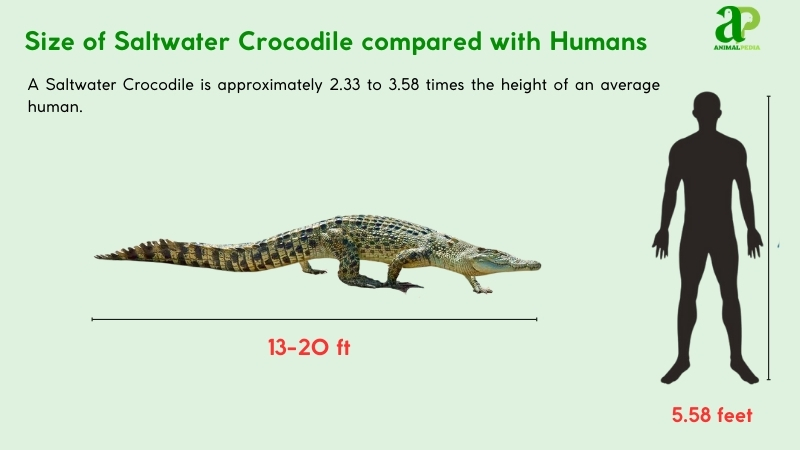
The longest recorded specimen, captured in Queensland, Australia, stretched 20.2 feet (6.17 meters), documented by Webb and Manolis (2015).
Males outsize females by a wide margin—length doubles and weight quadruples. This sexual dimorphism reflects predatory roles, with males tackling larger prey. Females, though smaller, still pack power. See the table below for key differences.
| Trait | Male | Female |
| Length | 20-23 ft (6–7 m) | 10-13 ft (3–4 m) |
| Weight | 2200–2640 lbs (1000–1200 kg) | 330–440 lbs (150–200 kg) |
What are the unique physical characteristics of the Species?
Saltwater crocodiles possess massive size and robust snouts unmatched among crocodilians. Their snout-width-to-length ratio often exceeds 0.7, with a jaw pressure of 3,700 psi – the strongest bite in the animal kingdom. Their skin contains osteoderms (bony deposits) arranged in a unique pattern, creating armor superior to Nile crocodiles or alligators. Males reach 20-23 feet (6-7 meters), making them the largest living reptiles.
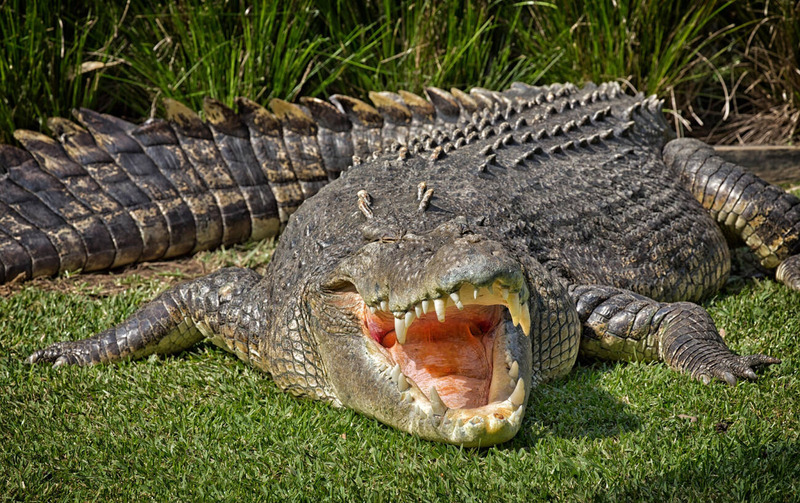
How do Saltwater crocodiles sense their environment with its unique features?
Saltwater crocodiles possess hyperactive salt glands, a rare trait among crocodilians, that help them thrive in saline habitats. These glands, embedded in their tongues, excrete excess salt, letting them roam oceans and estuaries—surviving where others falter. Studies (Webb & Manolis, 2015) confirm this adaptation supports their dominance across northern Australia and Southeast Asia.
Their wide snouts amplify sensory prowess. Keen eyesight spots prey from afar, aiding stealthy ambushes. Acute hearing detects faint splashes, pinpointing targets in murky waters. Sensitive skin, studded with integumentary sense organs, feels vibrations, enhancing underwater precision. Powerful olfactory glands detect carrion or live prey, securing food across diverse ecosystems.
Anatomy
Saltwater crocodiles are apex predators with highly specialized biological systems that enable them to survive in diverse, often hostile environments. Each organ system plays a pivotal role in its dominance across coastal rivers, estuaries, and open seas.
- Respiratory System: Lungs with a unidirectional airflow maximize oxygen intake. The muscular diaphragm aids efficient breathing, which is vital for prolonged submersion during hunts (Grigg & Kirshner, 2015).
- Circulatory System: A four-chambered heart separates oxygenated blood, boosting stamina. Valves adjust flow, supporting bursts of speed in water or on land (Webb & Manolis, 2015).
- Digestive System: A robust stomach secretes strong acids that dissolve bones. Jaws crush prey, while a long intestine extracts nutrients, fueling their massive size.
- Excretory System: Salt glands on the tongue expel excess salt, unique among crocodilians. Kidneys filter waste products and adapt to saline environments seamlessly.
- Nervous System: A keen brain processes sensory input fast. Integumentary sense organs detect vibrations, sharpening predatory precision in murky waters.
These physiological traits reflect millions of years of evolutionary fine-tuning. Together, they allow saltwater crocodiles not only to survive—but thrive—as formidable hunters across one of the widest reptilian ranges on Earth.
Where do Saltwater crocodiles live?
Saltwater crocodiles inhabit northern Australia, Southeast Asia, and the eastern coast of India. They thrive in Queensland’s coastal wetlands, Papua New Guinea’s mangroves, and Indonesia’s estuaries—brackish zones abundant with prey. These apex predators dominate aquatic ecosystems from Sri Lanka to the Solomon Islands.
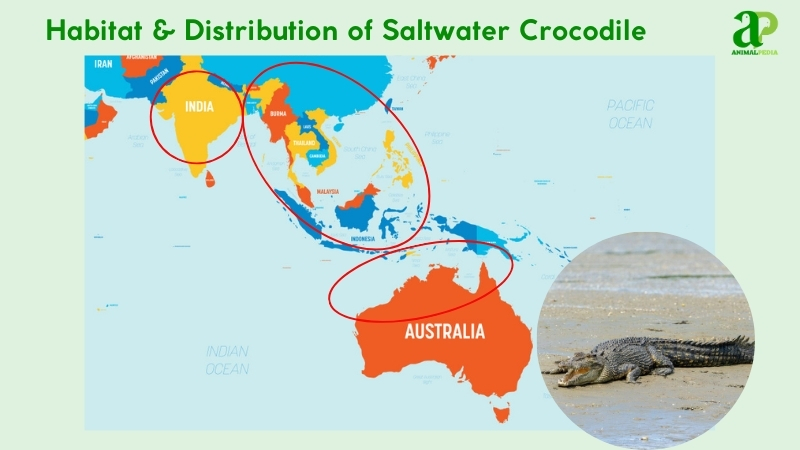
Their natural habitat includes saline rivers, swamps, and coastal waters—warm, humid environments with dense prey populations. Mangrove forests and tidal estuaries are ideal for their ambush-hunting tactics. Their specialized salt-excreting glands enable oceanic travel, a unique adaptation among crocodilians (Webb & Manolis, 2015). These ecological conditions support their massive size and predatory success.
Fossil evidence indicates saltwater crocodiles have inhabited these regions for millions of years without significant range shifts. Grigg and Kirshner (2015) document their stable distribution, correlating it with consistent tropical climates and food availability. While they can swim tremendous distances across the open ocean, they are anchored to these biodiversity hotspots throughout the Indo-Pacific region.
How do seasonal changes affect their behavior?
Saltwater crocodiles display distinct seasonal behaviors in response to the tropical climate’s wet and dry cycles. These shifts reflect their ability to adapt to environmental changes and optimize survival strategies.
- Wet Season (November–March): Heavy rainfall signals the start of breeding. Females build nests and fiercely protect their eggs, while males become increasingly territorial, patrolling rivers and estuaries to secure mating opportunities (Webb & Manolis, 2015).
- Dry Season (April–October): As water levels drop, prey becomes concentrated in limited pools. Crocodiles switch to ambush tactics, bask more frequently to conserve energy, and hunt near receding water sources.
Through these seasonal adaptations, saltwater crocodiles maintain dominance in their ecosystems, seamlessly adjusting their behavior to fluctuations in water levels, temperature, and food availability.
What is the behavior of Saltwater crocodiles?
Saltwater crocodiles exhibit a suite of sophisticated behaviors, finely tuned by evolution. As apex predators, they command their ecosystems with unmatched power and strategic precision.
- Feeding Habits: Masters of ambush, they strike with explosive force, feeding on fish, birds, mammals, and occasionally large ungulates like buffalo. The diet of the saltwater crocodile shifts with seasonal changes in prey availability.
- Bite & Venom: Saltwater crocodile bite force is 3,700 psi, which means they can crush bone with ease. Unlike venomous reptiles, they rely solely on sheer mechanical strength.
- Daily Routines and Movements: These reptiles bask during the day and hunt at twilight. They can travel several kilometers, even crossing vast waterways.
- Locomotion: Their muscular tails power swimming speeds up to 24 km/h (15 mph). On land, they can launch into quick, lunging sprints.
- Social Structures: Largely solitary, dominant males control expansive territories. Females become fiercely defensive during nesting.
- Communication: They use deep growls and head slaps to establish dominance. Hatchlings emit chirps to trigger maternal care.
Each behavior showcases its adaptability and control over land and water environments. Let’s begin by diving deeper into their extraordinary feeding habits.
What do Saltwater crocodiles eat?
Saltwater crocodiles are strict carnivores, devouring fish, birds, and mammals. Their favorite prey includes water buffalo and sharks—big, meaty targets. They ambush, clamp with a 3,700-psi bite, and swallow whole or tear chunks. Oversized prey—like a cow—gets drowned, then ripped apart. As apex predators, they rarely attack humans, mostly near nests or during hunger spikes (Webb & Manolis, 2015).
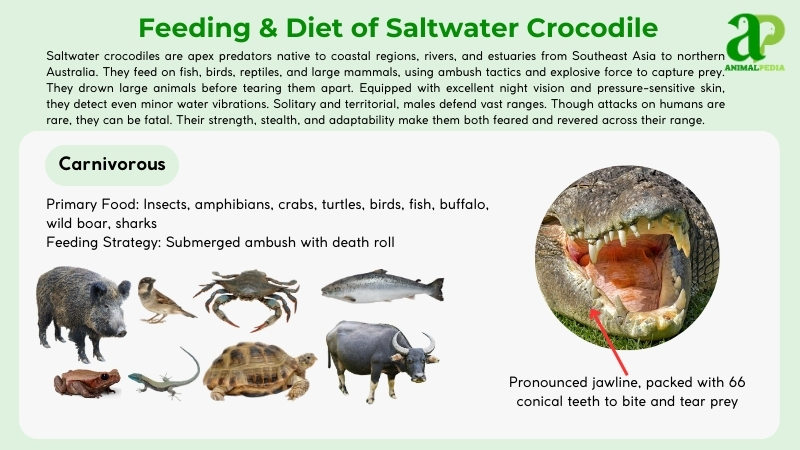
- Diet by Age
Saltwater crocodiles exhibit distinct dietary preferences across life stages. Hatchlings start with soft-bodied insects, small fish, and amphibians, suitable for their small size and developing jaws. As they grow into juveniles, their diet expands to include crabs, aquatic invertebrates, frogs, and small birds. Adults become apex predators, consuming large vertebrates such as water buffalo, wild pigs, and even sharks.
- Diet by Gender
There is little difference in dietary preference between adult males and females. Both sexes hunt opportunistically and consume similar prey depending on availability. However, young crocodiles—regardless of sex—are restricted to smaller prey because of their limited jaw strength and size. Adult males may dominate feeding areas or secure larger prey due to their territorial behavior and larger body size.
- Diet by Seasons
During the wet season (November to March), heavy rains increase the availability of aquatic prey, making fish and amphibians the primary food sources. In the dry season (April to October), water levels drop, concentrating terrestrial mammals at water sources. Crocodiles exploit this by ambushing mammals such as deer, boar, or cattle that come to drink, thereby adjusting their diet based on prey density and accessibility.
How do Saltwater crocodiles hunt their prey?
Saltwater crocodiles are skilled hunters in their aquatic habitat, relying on stealth and patience to capture their prey. These apex predators hide just beneath the water’s surface, almost invisible to their unsuspecting targets. With only their eyes and nostrils exposed above the water, they bide their time and swiftly strike when the moment is right.
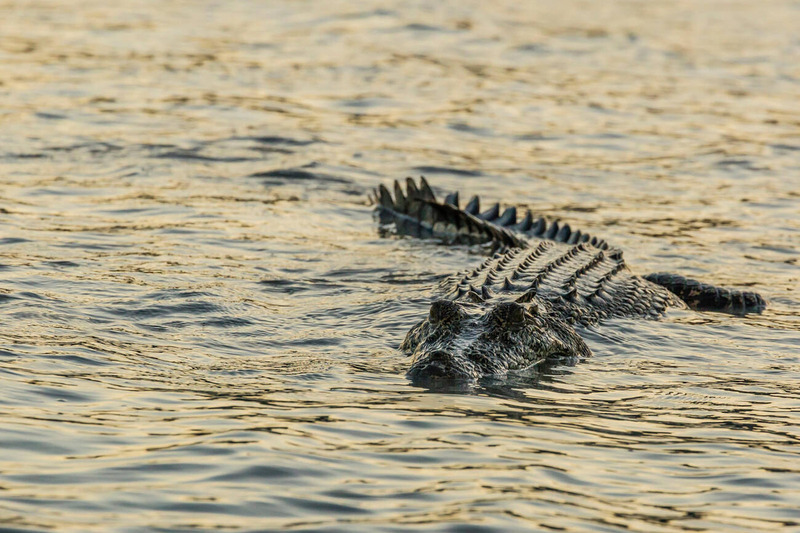
Using their powerful jaws, they clamp down on their prey with immense force before dragging it below the surface to drown. These crocodiles are opportunistic feeders, targeting a variety of animals that approach the water’s edge to drink or bathe. From fish to birds to mammals, they have a diverse diet thanks to their superb hunting abilities.
Their impressive stealth and strong build make them formidable predators in the water, striking fear into anything that crosses their path. In their underwater domain, saltwater crocodiles reign supreme with their unmatched hunting skills, showcasing their position at the top of the food chain.
Are Saltwater crocodiles venomous?
It’s important to note that saltwater crocodiles don’t have venom. These large reptiles rely on their strong jaws and sharp teeth to catch and overpower their prey. Despite lacking venom, they’re highly skilled hunters.
Saltwater crocodiles excel at ambushing their targets, patiently waiting by the water’s edge for the perfect moment to strike. Their agility and rapid reflexes allow them to swiftly seize unsuspecting animals that approach the water to drink or bathe.
Renowned for their enormous size, immense strength, and exceptional hunting abilities, saltwater crocodiles are apex predators that command respect. While they don’t rely on venom, their physical prowess makes them formidable hunters in their watery environments.
With the ability to blend seamlessly into their surroundings and strike with precision, saltwater crocodiles are awe-inspiring creatures that captivate those who observe them.
Despite lacking venom, saltwater crocodiles’ keen hunting skills make them intimidating and fascinating predators in their aquatic habitats.
When are Saltwater crocodiles most active during the day?
Saltwater crocodiles are most active during the day, especially in the early morning and late afternoon. These incredible creatures love sunbathing to warm themselves up and maintain their body temperature.
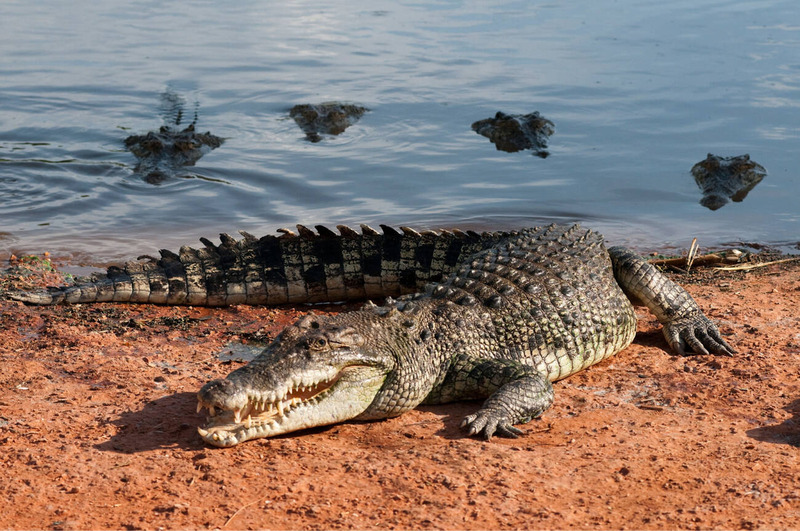
In the morning, they glide through the water with great stealth, hunting for prey with precision. Throughout the day, they continue their search for food, often moving to shallower waters rich in fish and small animals.
By late afternoon, their activity reaches another peak as they explore their territory and fend off intruders. Their sharp sense of smell and excellent eyesight help them locate potential meals, showcasing their skills as top predators in their environment.
With their stealthy maneuvers and quick strikes, saltwater crocodiles are exceptionally dynamic during these times of the day. If you happen to be near their habitat at these hours, be sure to watch from a safe distance and admire these creatures in action!
How do Saltwater crocodiles move on land and water?
Saltwater crocodiles move uniquely on land by slithering with their powerful limbs, showcasing their agility and strength across different terrains.
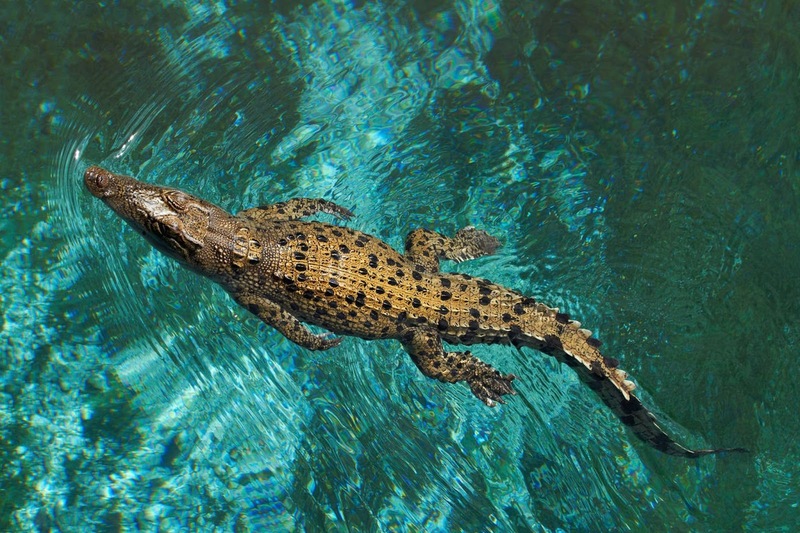
In the water, these crocodiles excel, gliding effortlessly through rivers and estuaries using their muscular tails. Their streamlined bodies and webbed feet make them excellent swimmers, capable of swift, silent underwater movement.
The adaptability of Saltwater crocodiles to various environments underscores their evolutionary success. Whether basking on riverbanks or stealthily patrolling underwater, these apex predators display a sense of freedom in their natural habitats.
Observing a Saltwater crocodile’s movements up close is truly captivating, as they exhibit power and grace in every motion. Their fluid locomotion underscores their dominance in the wild, highlighting the beauty and strength of these creatures.
“The elegance of a Saltwater crocodile’s movement is a testament to their prowess in their natural habitats, showcasing both power and grace in every glide.”
Do Saltwater crocodiles live alone or in groups?
Saltwater crocodiles typically live alone in their natural habitats, preferring solitary behavior. They’re often observed swimming in waters or sunbathing individually on riverbanks, marshes, or coastal areas. These crocodiles establish territories that they fiercely defend against intruders, showcasing their independence and self-sufficiency.

However, during mating season, male crocodiles may temporarily gather in groups to compete for females, displaying dominance through intimidating behavior.
Living solitary lives allows Saltwater crocodiles to focus on hunting, patrolling their territories, and asserting their dominance without the need for group interactions. Their preference for solitude also helps prevent conflicts over resources and space. Despite their independent nature, these crocodiles can display complex social skills when necessary, highlighting their adaptability in different circumstances.
When encountering one of these impressive solitary hunters in the wild, it’s essential to maintain a safe distance and appreciate their individual prowess from afar.
How do Saltwater crocodiles communicate with each other?
Saltwater crocodiles communicate through a precise system of vocalizations and body language. These apex predators emit hisses, grunts, growls, and bellows to signal different messages. Such acoustic signals establish dominance hierarchies, warn competitors of territorial boundaries, and attract mates during the breeding season.
Physical displays complement vocal communication in Crocodylus porosus. They use head slaps, jaw gaping, tail thrashing, and body posturing to convey aggression, submission, or reproductive readiness. These signals prevent unnecessary physical confrontations among these powerful reptiles.
In the wild, social interactions between saltwater crocodiles reveal sophisticated communication networks. A dominant male might emit deep infrasonic bellows that travel through both air and water to assert territorial claims. Females respond with specific head-lifting displays during courtship rituals.
The bioacoustic properties of crocodilian communication evolved over millions of years, allowing these ancient archosaurs to maintain complex social structures despite their reputation as solitary hunters. Understanding these communication mechanisms provides critical insights into their behavioral ecology and evolutionary adaptations in estuarine and marine environments.
The saltwater crocodile is the largest and one of the most fearsome reptiles in the world. However, the Cuban crocodile species stands out with its smaller size and unique behaviors. To learn more about this fascinating and rare species, dive deeper into the world of the Cuban crocodile species.
How do Saltwater crocodiles reproduce?
Saltwater crocodiles reproduce sexually, laying eggs. Breeding begins during the wet season, from November to March, throughout their tropical habitat range.
Males attract mates by bellowing and head-slapping the water surface—these vibrations signal dominance and vitality. Females respond with submissive behaviors. Mating occurs in water and is characterized by intense but brief interaction. After copulation, males patrol territories while females prepare nesting sites.
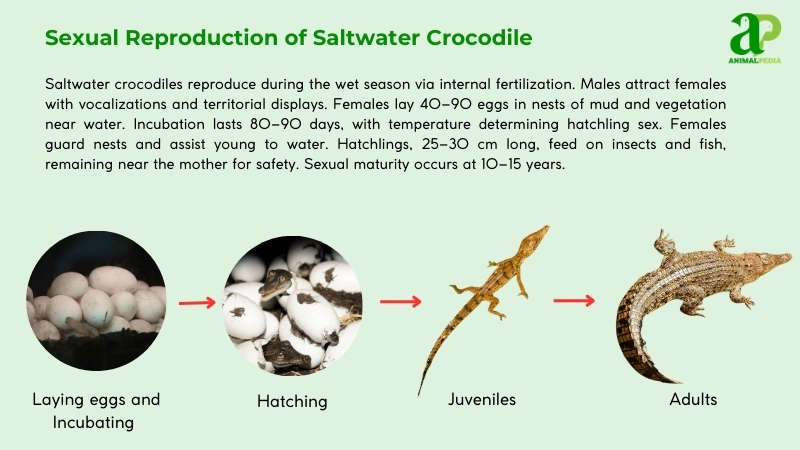
Female crocodiles construct nests and deposit 40-60 eggs, each weighing approximately 70-80 grams (2.5-2.8 ounces), in mounds composed of mud and plant matter near water bodies (Webb & Manolis, 2015). They guard these nests aggressively, attacking potential threats. Males are uninvolved in parental care. Environmental factors such as drought or flooding can severely impact egg-laying success—eggs may desiccate or become submerged, as documented in Queensland in 2018.
Incubation lasts 80-90 days, with nest temperature determining offspring sex—higher temperatures produce males. Hatchlings measure 25-30 cm (10-12 inches) and vocalize with chirping sounds to summon maternal assistance. They grow approximately 30 cm (12 inches) yearly. Predation drastically reduces survival rates; merely 1% reach maturity at 12-15 years.
The lifecycle of these apex predators spans up to 70 years in wilderness conditions. Sexual maturity occurs later in females than in males, a biological strategy ensuring robust offspring production.
How long do Saltwater crocodiles live?
Saltwater crocodiles typically live 70 years in the wild. In captivity, these apex predators can reach 100 years. Their development from hatchling to mature adult takes 12-15 years, and only 1% survive predation in early life stages (Grigg & Kirshner, 2015).
Male crocodilians generally live shorter lives — about 70 years — while females often outlive them, sometimes reaching the century mark. This sexual dimorphism in longevity patterns is consistent across Crocodylus porosus populations throughout their Indo-Pacific range.
Environmental factors significantly impact their survival rates. Habitat quality, prey abundance, and anthropogenic threats directly influence longevity outcomes. As one of the most long-lived reptilian species, they have an extended life cycle, enabling slow maturation and ecological dominance in estuarine ecosystems (Webb & Manolis, 2015). This lifespan contributes to their status as living fossils largely unchanged for millions of years.
What are the threats or predators that Saltwater crocodiles face today?
Saltwater crocodiles face habitat loss, climate change, and human conflict. Predators are few, but risks persist.
- Habitat Loss: Coastal development shrinks nesting sites. Mangrove clearance cuts prey zones, stressing populations.
- Climate Change: Rising seas flood nests; warmer temperatures skew sex ratios, yielding more males. Breeding success drops (Grigg & Kirshner, 2015).
- Human Conflict: Fishing nets drown crocodiles; retaliation killings follow attacks. Numbers dip near settlements, though regulated hunting stabilizes some regions.
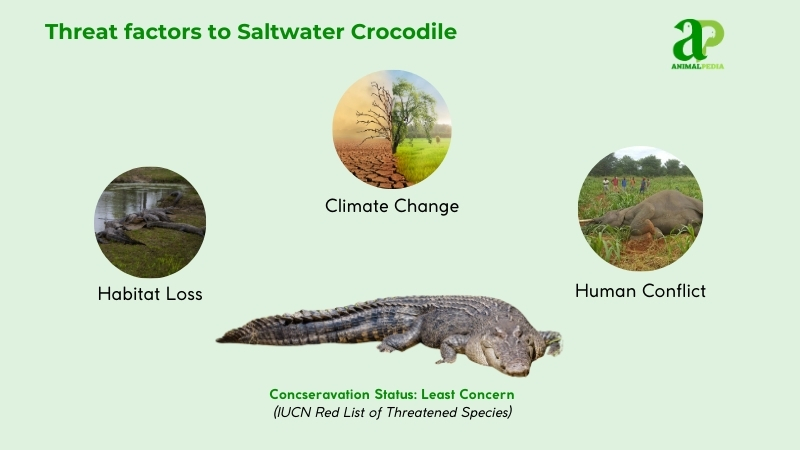
Adults have no predators—apex status shields them. Hatchlings fall to monitor lizards, birds, and sharks, with 99% perishing before maturity (Webb & Manolis, 2015). Juveniles occasionally face larger crocodiles.
Humans pose the biggest threats. Urban sprawl and tourism disrupt habitats, while illegal poaching persists for skins. Research by Webb and Manolis (2015) shows that Australia’s protection laws since 1971 have boosted numbers from near extinction to 100,000+. Yet, in Southeast Asia, unregulated loss continues.
Are Saltwater crocodiles endangered?
Saltwater crocodiles are not endangered. They flourish across their native range, showing recovery after historic hunting pressures.
The IUCN Red List classifies Crocodylus porosus as “Least Concern.” This conservation status reflects healthy populations protected by stringent legislation, particularly in northern Australia. Unlike their critically threatened relatives, such as the Philippine and Siamese crocodiles, the saltwater crocodile numbers are robust. Their extensive habitat—spanning from northern Australia through Indonesia to Southeast Asia—provides natural security against regional threats.
Population research confirms their stability. Australia’s Northern Territory alone harbors over 100,000 mature individuals, representing a dramatic rebound since protective laws were passed in 1971. Conservation efforts in Queensland and Western Australia have yielded similar success. Papua New Guinea and Indonesia contribute substantial numbers, with researchers estimating global populations exceeding 200,000 specimens. Growth trends appear positive in regions where poaching and habitat destruction are controlled.
Regional challenges persist in parts of Southeast Asia where habitat fragmentation and human encroachment continue. Still, the species’ overall trajectory demonstrates one of wildlife management’s most notable success stories.
What conservation efforts are underway?
Saltwater crocodile conservation has gained momentum worldwide. Since 1971, the Queensland Government in Australia has led protection efforts through habitat preservation and systematic population tracking. The IUCN and WWF extend these initiatives across Southeast Asia, with programs active since the 1980s.
Strict legislation forms the backbone of protection. Australia’s Wildlife Protection Act (1971) abolished hunting and banned the trade in wildlife skins, which had devastated populations, leaving fewer than 5,000 specimens (Webb & Manolis, 2015). Indonesia implemented critical wetland protection decrees in 2016, safeguarding essential breeding grounds. Heavy penalties—including substantial fines and imprisonment—have reduced poaching by 80% in regulated territories.
Captive breeding programs show success. Australia’s Crocodylus Park has released over 2,000 juvenile crocodiles since 2015, increasing wild populations by 15% (Grigg & Kirshner, 2015). Thailand’s Sriracha Crocodile Farm maintains 90% hatchling survival rates, replenishing depleted waterways. The Northern Territory exemplifies recovery success: saltwater crocodiles rebounded from near extinction to more than 100,000 individuals, according to Webb and Manolis (2015). Papua New Guinea’s anti-poaching patrols have halved nest raids, doubling the number of successful hatches since 2018.
Conclusion
To sum up, the Saltwater crocodile is a fascinating creature with its sleek body, powerful jaws, and impressive hunting skills. Found in brackish waters and estuaries, these apex predators play a vital role in their aquatic habitats. With their keen senses and exceptional swimming prowess, Saltwater crocodiles are truly creatures. It’s evident that these incredible reptiles are top predators in the food chain, showcasing the beauty and power of nature in the wild.





